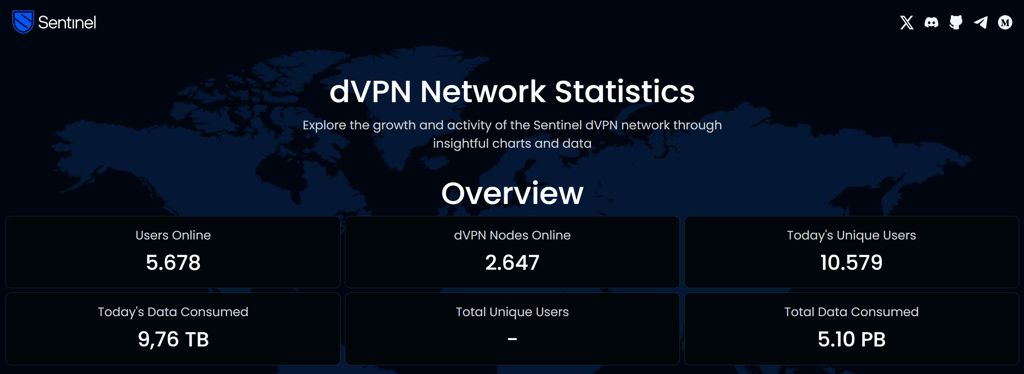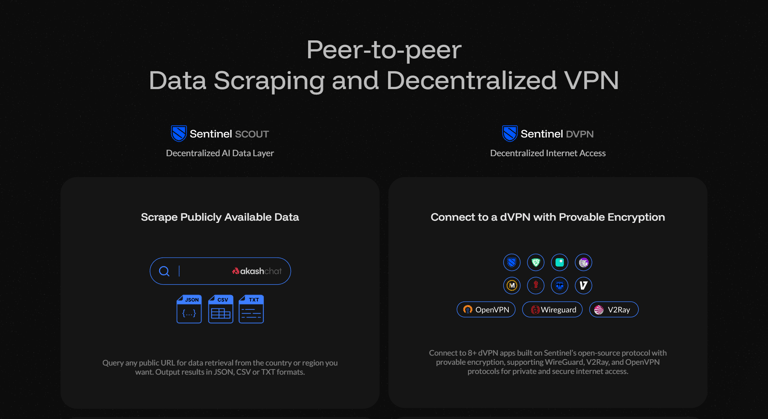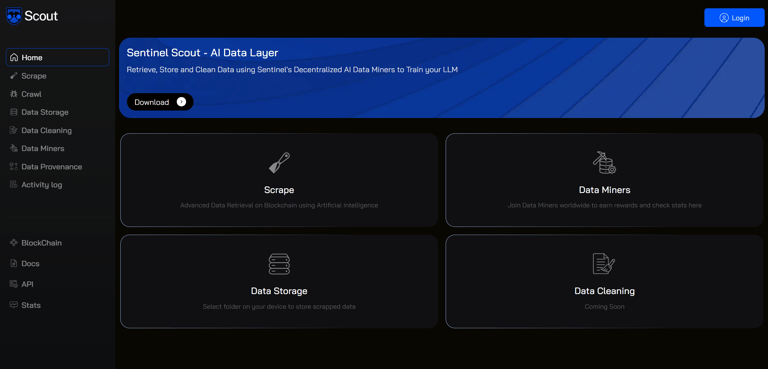Sentinel: the blockchain for P2P bandwidth
Introduction to Sentinel: the peer-to-peer bandwidth blockchain powering dVPNs, decentralized data scraping, and more
COSMOSPROOF OF STAKE
Bitveil Team


If you’ve felt that the modern internet has turned into a surveillance playground, you’re not alone. Between ad tech pipes that shadow you across sites, ISPs that can be compelled to log and retain data, and “privacy” products whose terms read like a lawyer’s crossword puzzle, the default web experience is trackable by design.
Traditional VPNs try to patch that experience with a single provider: you must trust one company, one set of servers, one database that can be pressured, blocked, or compromised.
Sentinel takes a very different path. It is not a single VPN service. It is a L1 blockchain that turns internet bandwidth into a peer-to-peer marketplace; a base layer other applications can build on.
The best-known app class on Sentinel today is decentralized VPN (dVPN), but that’s only the start.
The same primitives that route encrypted traffic between peers can also distribute data-gathering jobs across a global mesh of contributors; an approach Sentinel is using to decentralize web scraping and real-time data acquisition for AI via Sentinel Scout.
In other words, Sentinel is an internet bandwidth economy: people provide network resources, others consume them, and the marketplace clears payments without a central operator.
This article is a deep dive: why centralized VPNs fall short, how Sentinel works under the hood, what makes its dVPN network different, how Scout brings decentralized data scraping to AI agents, and where community culture - Bluefrens, Sentinel’s Genesis collection - fits into the bigger picture.
What is Sentinel?
At its core, Sentinel is a Cosmos-SDK, proof-of-stake blockchain purpose-built to meter and settle bandwidth exchanged between peers. Think of it as a settlement and coordination layer for network services: a neutral marketplace where node operators sell connectivity and users buy it, with the ledger keeping the accounting tamper-evident.
If bandwidth is the product, dVPN is just one vertical. The same backbone that matches users with exit nodes can also match requesters with data miners to run network tasks: scraping public pages, fetching dynamic content, or piping fresh, permissionless data into AI systems.
Sentinel’s chain records who paid whom for how much verifiable work, while open competition among nodes keeps prices efficient and the network resilient.
Sentinel Scout: decentralized data scraping for AI
How Sentinel dVPN actually works
Most traditional, centralized, VPNs funnel your traffic through a branded fleet of servers.
Sentinel flips that model into a node marketplace:
Node operators provide bandwidth and sells it on the marketplace
Users select nodes based on performance, jurisdiction, price, or trust profile.
Usage is measured and settled as on-chain payments, with the ledger acting as a metering/auditing backbone rather than a surveillance point.
A key piece here is the network’s distributed hash table (DHT), which helps peers discover nodes.
Clients don’t need to phone home to a single vendor API to find servers; they look them up in a distributed way and establish encrypted sessions directly. That architecture underpins both dVPN and Scout (more on Scout shortly).
On the user side, there’s growing client diversity. Sentinel supports a growing number of apps and vendors like: Sentinel Shield (flagship DVPN), Meile DVPN, Norse DVPN, Valt Data. But also Cosmo dVPN: a client that emphasizes simple subscriptions and the ability to pay with ATOM (Cosmos’ hub coin) rather than only the Sentinel asset.
The result? A VPN experience that’s harder to block, easier to verify, and more resilient because there is no single company to pressure. Sentinel reports sustained growth and widespread usage across its app ecosystem; the network has supported large, active user bases as the clients matured: evidence that a decentralized model can work at consumer scale.
The web is increasingly dynamic, personalized, and guarded by anti-bot systems.
Centralized scraping services are expensive, brittle, and easy to block.
Sentinel’s answer is Scout, an AI data layer built on the same peer-to-peer principles: network of “data miner” nodes that accept work orders, fetch public data from the open web, and return results through the protocol, already processed for LLM training.
Think “swarm of mobile proxies with on-chain incentives.”
Bluefrens: the Genesis NFT collection and why culture matters
Infrastructure wins on utility. Movements win on culture.
Sentinel’s Genesis collection, Bluefrens, lives at that intersection.
Bluefrens is a collection of 1,420 pixel-art PFPs sold out on Stargaze, bringing exclusive perks and benefits for all the products in the Sentinel ecosystem.
Bluefrens collection has been designed and launched by us from Bitveil to celebrate privacy and decentralization in a playful, on-brand way.
Why mention an NFT drop in an article about infrastructure?
Because culture is an adoption vector. Bluefrens doesn’t replace docs or dashboards; it amplifies them putting a friendly face on a serious mission and giving contributors a badge of belonging.
It’s the same reason open-source projects have mascots and stickers: symbols make movements sticky, and sticky movements ship more software.
Bitveil’s role in Sentinel
The marketplace flywheel: why P2P wins over time
P2P systems endure because their incentives match reality:
More suppliers → better coverage. As more node operators show up (for dVPN or Scout), coverage gets broader, latency drops, and resilience improves.
More demand → better earnings. As users or agents consume more bandwidth/data, the APR for running nodes becomes attractive, which pulls in more suppliers.
Composability → new services. Once you can reliably meter/settle for bandwidth and jobs, other primitives: relay markets, specialized exit nodes and domain-expert scraping clusters become feasible.
The recent emphasis on the P2P ticker wasn’t marketing; it was a statement of scope.
Sentinel is explicitly positioning itself as the bandwidth layer the rest of Web3 can plug into: just as compute, storage, and rollup DA layers have emerged as modular pieces.
At Bitveil, we don’t just validate, we contribute.
On Sentinel, we run our own validator and actively contribute across the stack: the Telegram-based Sentinel Node Monitor for operators, the design and launch of the Bluefrens NFT collection to grow ecosystem culture, and meaningful contributions to the rework of the Python SDK to make developers’ lives easier.
This is what we love about Sentinel: it’s permissionless. If you have an idea that helps users, improves operator ergonomics, or advances privacy tooling, you can show up and build, then let the market reward you.
If our work resonates, support us by delegating your P2P to the Bitveil validator.








© 2025 Sociable Weavers s.r.l.
UNVEIL WEB3 POTENTIAL

